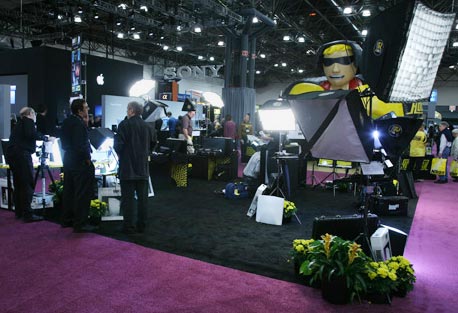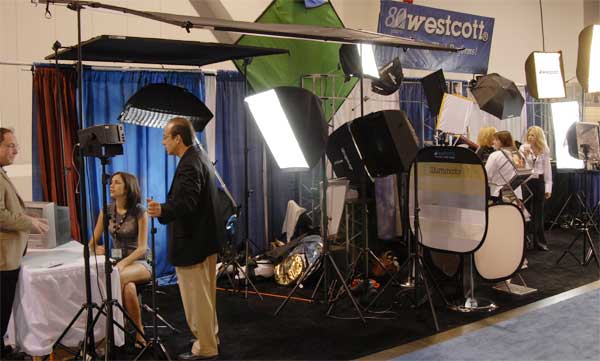HMI, tungsten, halogen (HQI), or even fluorescent lighting? Digital photography may require a different kind of lighting.
Reviews from the FLAAR digital photography test center.
The FLAAR photography crew had a successful six years photographing pre-Columbian Maya art in Guatemala and Honduras with digital cameras. We had the opportunity to test the two models of BetterLight large format digital camera system this entire grueling period. The last five years we have had the newer BetterLight Super 6K at work in Central America. These cameras hold up to constant travel just fine.
When I first entered the digital era, no one really explained that digital systems react differently to lights than film. Fortunately Michael Collette is a specialist in both digital reality and lighting, so I gradually began to get digital experience. He has written an excellent paper on this subject, available on the Scandles Web site of Plume Ltd.
The following comments on lighting for digital photography Were written in 1999 (yes, we were already reviewing digital Photography equipment that long ago). But despite this early date, it is still helpful to learn about the different kinds of studio lighting that were and still often are available today in 2016.
Since I began learning about the special needs of lighting for digital photography, I have begun to notice all kinds of conflicting reports on various kinds of lighting. I believe it was the Hasselblad web site that even claimed tungsten lighting was bad for digital. That was a rather unexpected conclusion, since I just spent 6 months taking over 1000 digital photographs almost entirely with tungsten lighting, and the pictures look just fine.
Tungsten lighting may melt your subject, if you shoot ice cream, and tungsten lighting does heat up the studio, which is stated to be undesired by the CCD inside your scanning camera. But tungsten lighting is wonderful for film-based photography, so I have no intention of throwing away my Lowel lamps quite yet. Besides, some hot light companies are redesigning their lights to work better with digital equipment. For example, one model of Dedolights may have contributed to serious electrical interferrence resulting in banding that ruined scores of our photographs. Now Dedo Weigert says his other model avoids this problem (but this does not help if you already bought eight units of the wrong kind of Dedolights!). So be sure you test your equipment before you face a deadline--or have to photograph 5000 kilometers away from home. The best kind of insurance for your lighting (for high-end digital photography) is to be sure your electrical circuits can provide constant voltage power. Sola hevi-duty electrical equipment can solve this type of problem.
 |
| Lowel booth at PhotoPlus 2005 tradeshow. |
In many ways I prefer tungsten lighting, especially when I still use 35mm film, medium format, or 4x5 film. If you need lamps for your studio lights, try out BulbMan. But tungsten lighting is too hot for fragile objects in museums. Curators overheat just thinking about heat from photo lamps. So FLAAR is dedicated to testing various other kinds of lighting for museum conservation and archaeological photography. After all, we have over 37 years experience in photographing delicate artifacts from Mayan archaeological excavations.
The use of fluorescent lighting is making considerable inroads in digital photography as studios realize it is a cost-effective way to do lighting for the new era in photography. The new Videssence fluorescent lighting is not the old fashioned kind which was instant death to color balance when you used film. The new SRGB tubes are specially made for professional photography. Furthermore, they are friendly to CCD electrical preferences. Downside of Videssence is that their fixtures are intended to hang from the ceiling of television studios. These fixtures are totally inappropriate for a photo studio situation. Lowel has a much better design for their fluorescent lighting, especially if you wish to have portable fluorescent lamps for shooting on location with a digital camera. The highest power fluorescent lighting comes from Balcar. We like these very much (we do not have the Lowel fluorescents, nor the newer Westcott Spyder fluorescent lighting).
A nice kind of lighting for professional digital photography with scanning backs (such as Better Light, PhaseOne, Dicomed, etc) are cool tungsten SunSpots by North Light Products. Contact. northlightproducts.com, attn David Christensen, david@northlightproducts.com. NorthLight makes tungsten, but cool to the touch (and cool to the artifacts). NorthLight also makes fluorescent lighting for professional digital photography: indeed it is industrial strength lighting.
Strobe or flash cannot be used on the high-end large format digital systems such as Dicomed Studio Pro, PhaseOne, or Better Light. These cameras record such precise detail, however, that being unable to use strobe is still worthwhile.
Whether HMI lighting can evolve to replace strobe and tungsten remains to be seen. Technical reports vary widely in their opinions whether HMI lighting is ideal for digital. Part of the problem is that a test lab may see digital artifacts with a magnifying glass that will not show up on a normal picture unless you enlarge it to cover the side of the Empire State Building. LTM Pepper produces HMI lighting which has evidently proven to be ideal with high-end digital photography. We hope to test some Peppers soon.
Between the evolution of "tungsten" filters, improvements in the software, and new designs for lamps, everything is still in flux. This particular note is just to alert digital photographers to do careful testing of lighting before they accept an assignment with their fancy new digital system. I wholeheartedly recommend going digital; the new Better Light system is clearly superior to most aspects of 4x5 film photography, but look before you leap.
Since the FLAAR. Photo Archive staff does not sell any brand or class of lighting, we can remain neutral in the war of standards and brand names that is breaking out as companies realize there is a gold rush to produce equipment compatible with the new digital camera systems.
So far, as a system, the Videssence SRGB class of fluorescent lighting seems to have the most future for digital photography. Unfortunately the Videssence fixtures are too clunky. Thus we recommend Balcar, Lowel fluorescent, or the new fluorescent lighting from Westcott.
 |
Westcott stand from PMA 2007 Unfortunately PMA no longer exists as such. PMA is occasionally coordinated with the giant CES, in early January, in Las Vegas, as PMA@CES. I would need to check to see whether studio lighting companies still exhibit here. But today, in 2016, PhotoPlus is the best digital photography and studio equipment expo in North America. Westcott has exhibited here in all past years that I have attended. |
Just as DOS overwhelmed CP/M, and as Windows operating system took over the world of computers (and then Apple operating systems) so also fluorescent lighting will overtake the traditional lighting systems just as soon as the lamp manufacturers can up the candle power of fluorescent.
At the other end, however, the CCD manufacturers and the software designers are making the new generation of high-end digital camera work well on less light power. The '97 second generation Better Light already achieves considerable advances over the '96 first generation Better Light. '02 has already brought even further improvements.
Today (2016) a lot has changed, and we will be updating this page during and after Photokina 2016 in Cologne.
Most recently updated January 28, 2016.
Previous updates Dec 3, 1999, updated Oct 26, 2002, and July 4, 2005..